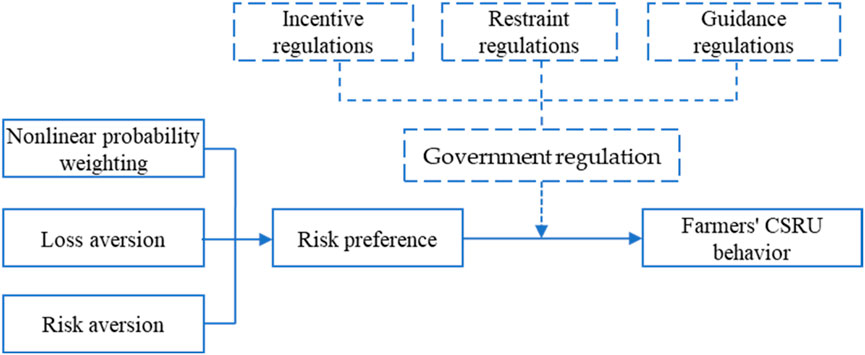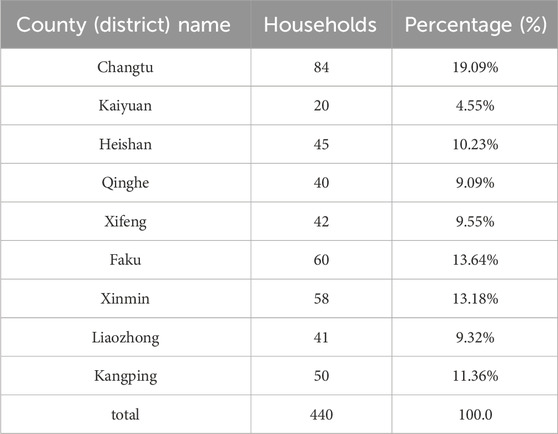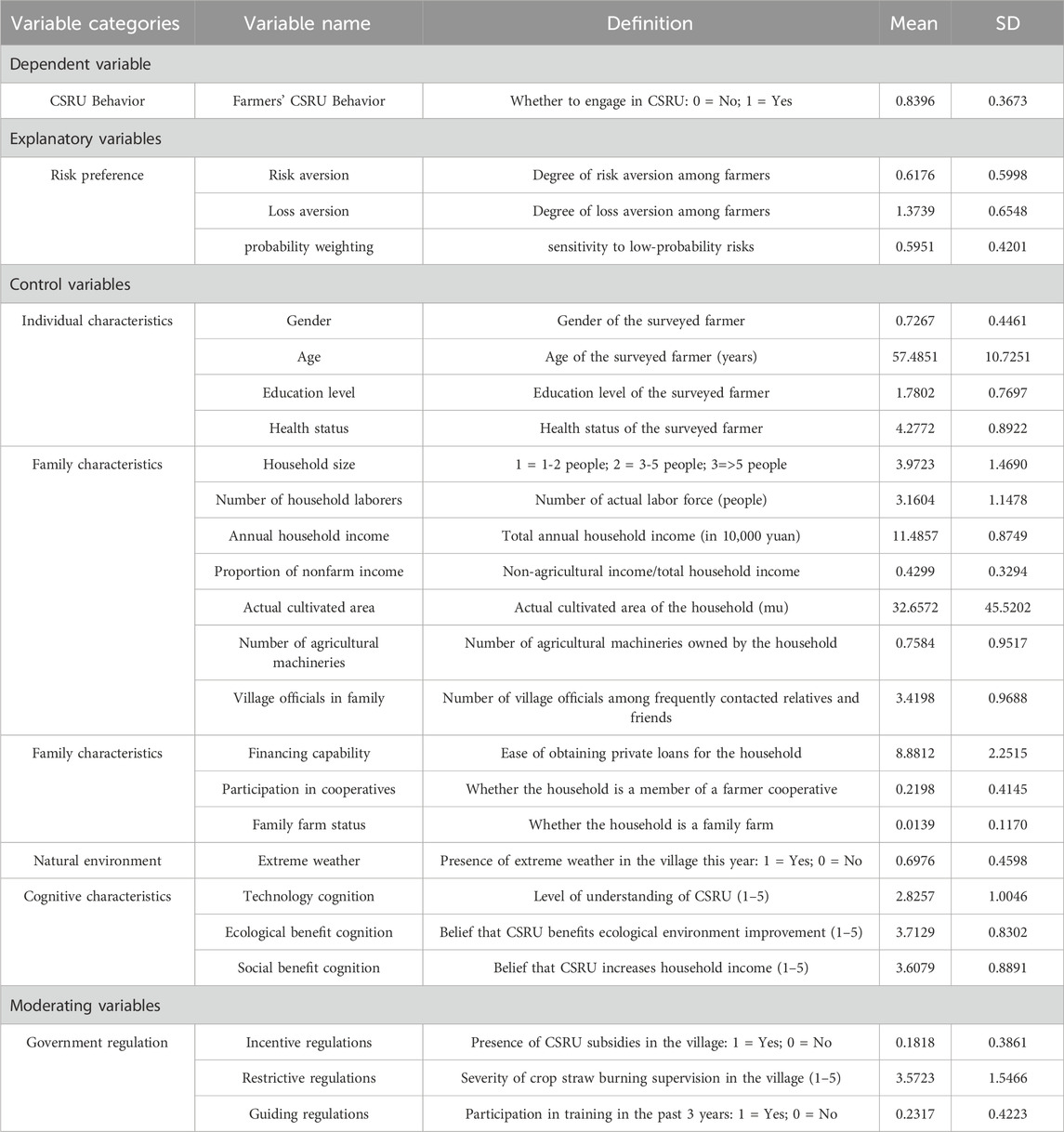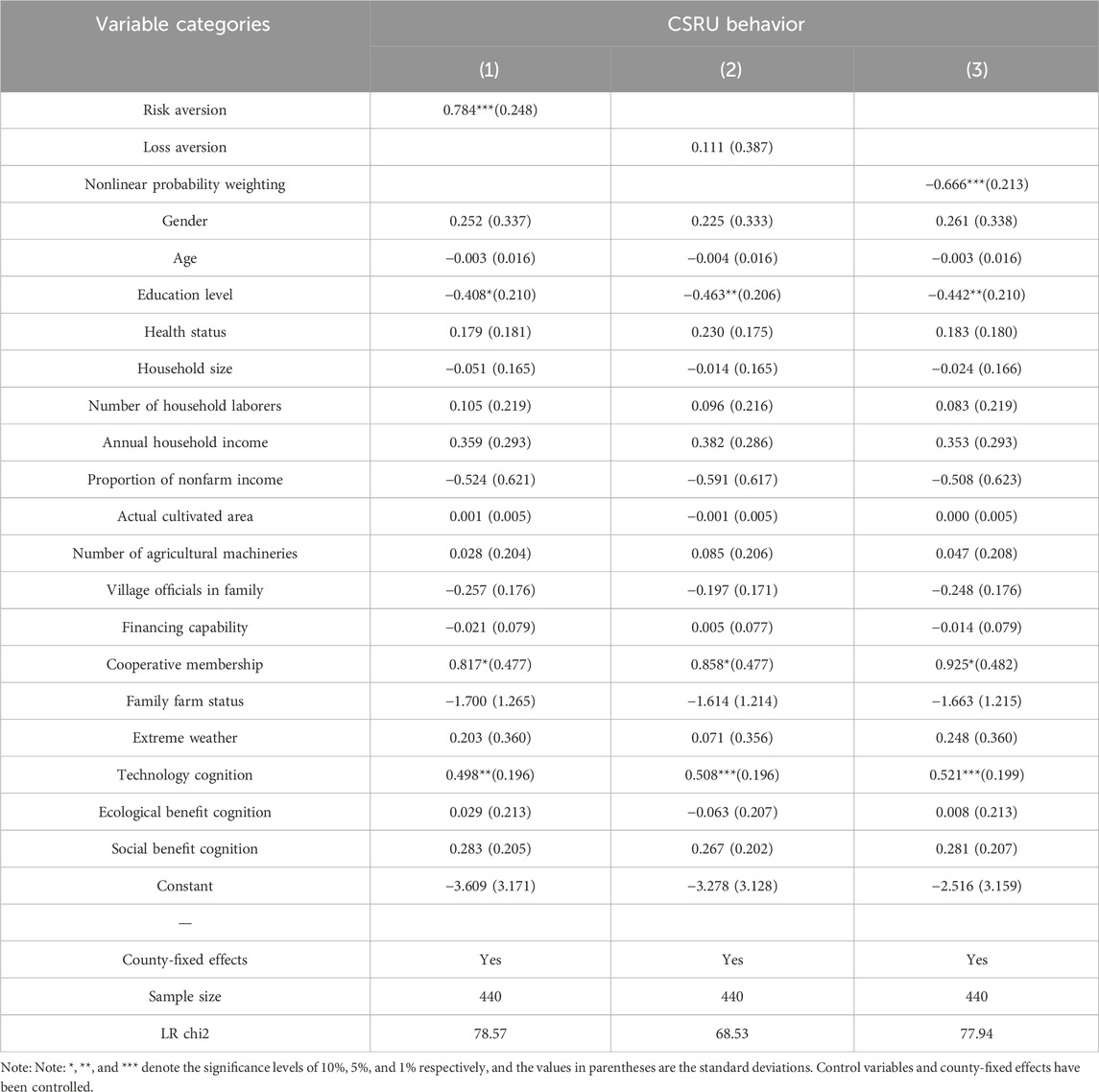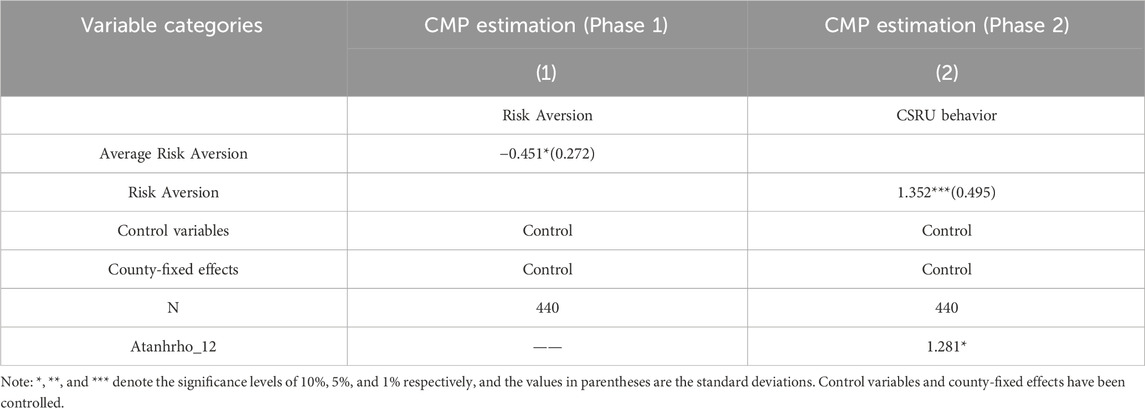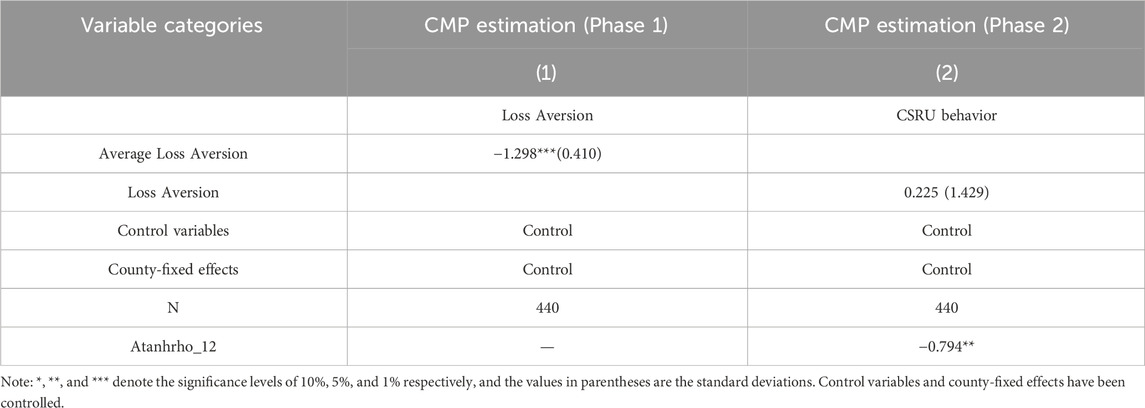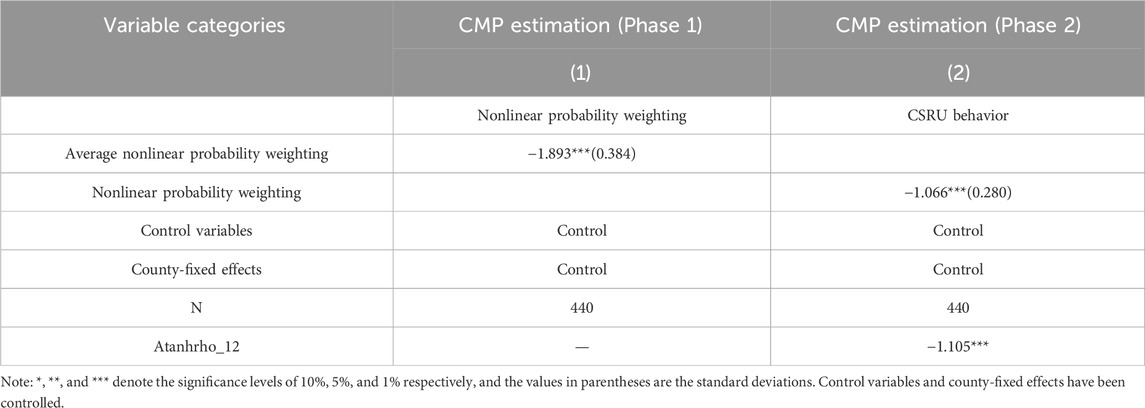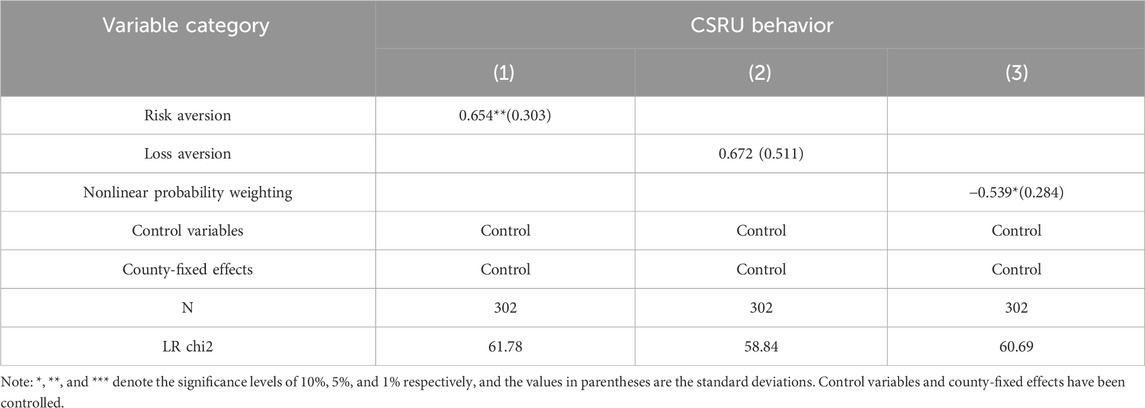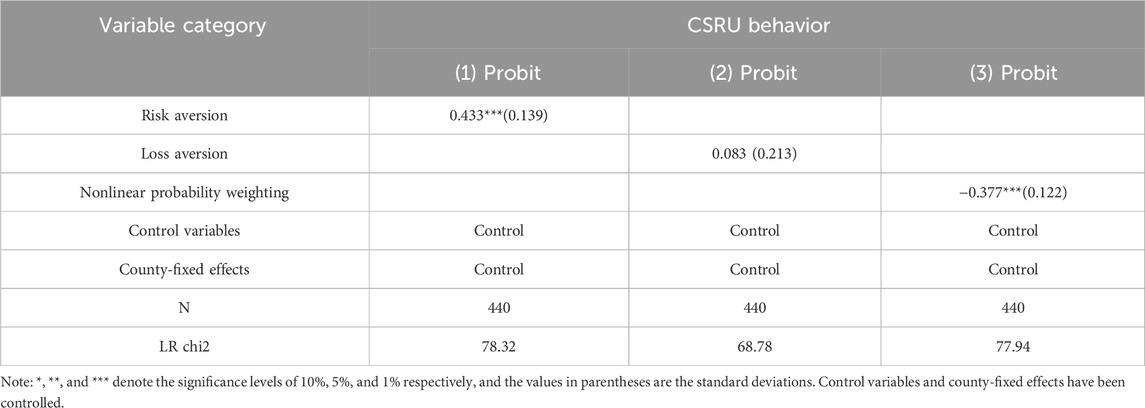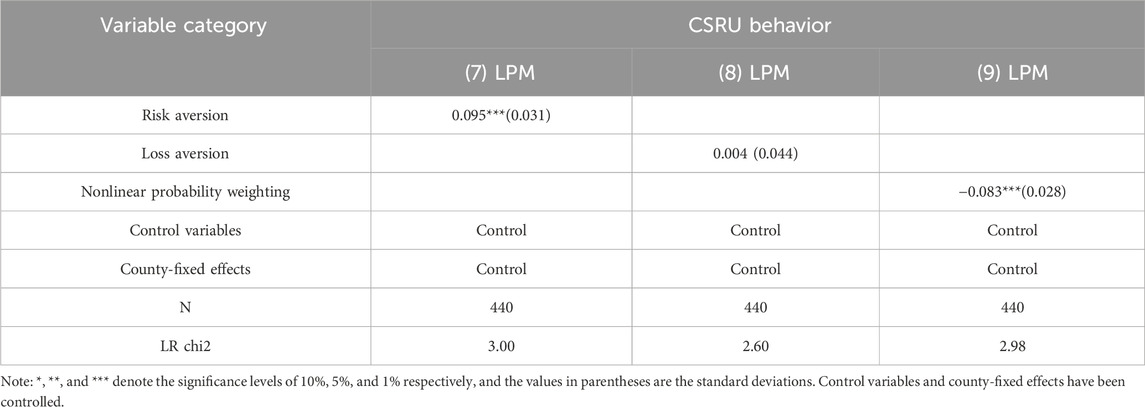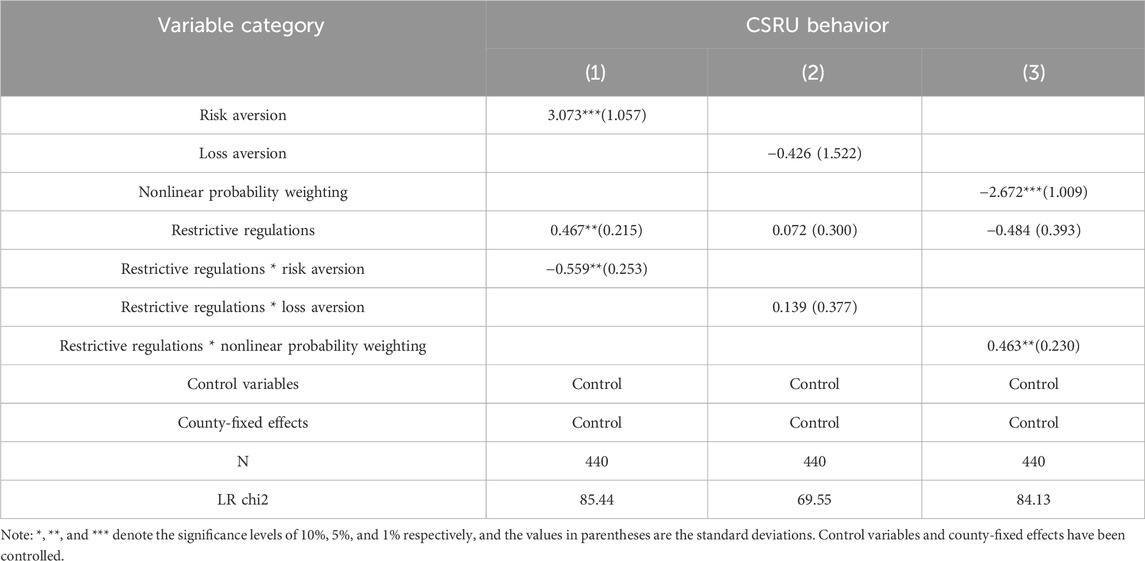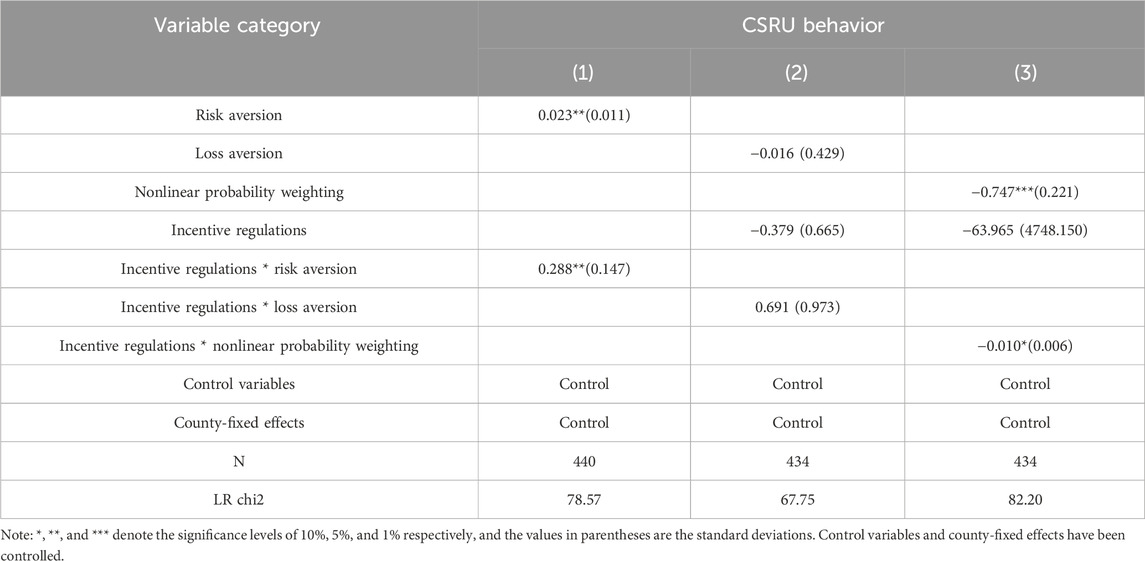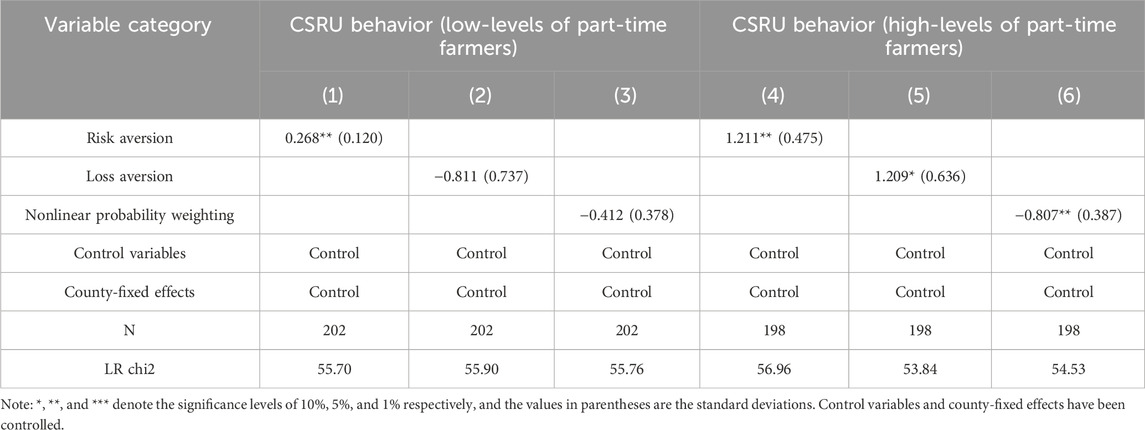- 1College of Economic and Management, Shenyang Agricultural University, Shenyang, Liaoning, China
- 2Party School of Liaoning Provincial Party Committee, Shenyang, Liaoning, China
- 3Agronomy College, Shenyang Agricultural University, Shenyang, Liaoning, China
Introduction: Global crop straw production has increased sharply, leading to serious challenges in straw burning and disposal. The unsustainable practice of open burning wastes valuable renewable resources and poses significant environmental threats, such as air pollution and soil degradation, that undermine global agricultural sustainability. Despite extensive efforts by the Chinese government to promote crop straw resource utilization (CSRU), low farmer participation and the reliance on a singular technological structure remain persistent issues.
Methods: Drawing on prospect theory, this study integrates behavioral economics and policy analysis to examine how farmers’ risk preferences, including risk aversion, loss aversion, and nonlinear probability weighting, interact with heterogeneous government regulations, such as incentives, restrictions, and guidance, to shape CSRU behavior. Using micro-survey data from 440 rural households in Liaoning Province, China, we apply a logit model to quantify these relationships and analyze the moderating role of specific government policy measures.
Results: The empirical results show that farmers generally exhibit strong risk aversion, which increases the average probability of CSRU adoption by 10.56%, meanwhile an excessive focus on low-probability risks significantly promote adoption willingness. Furthermore, fiscal incentives such as direct subsidies effectively amplify the positive effect of risk aversion, increasing its marginal impact by 23.7%. In contrast, relying solely on regulatory measures tends to weaken this positive effect by increasing compliance costs, thereby reducing the adoption probability by 5.22%. Additional analysis reveals heterogeneity in responses based on income structures and business models: high-level of part-time farmers exhibit a much stronger response to government regulations, with their risk aversion effect being approximately 3.5 times that of low-level of part-time farmers.
Discussion: By synthesizing insights from behavioral and environmental economics, this study elucidates the mechanism through which economic risks are balanced in the CSRU adoption process and highlights the critical regulatory role of government policy tools. The findings provide empirical evidence and policy insights for optimizing resource management, formulating more cost-effective environmental policies, and promoting the green transformation of agriculture.
1 Introduction
As of 2022, the total global production of major crops reached 9.6 billion tons (FAO, 2024), an increase of 56% compared to 2000. This surge in grain production has been accompanied by a significant rise in straw generation (Zhang et al., 2025). The sharp increase in global crop straw production has led to serious environmental threats. Open burning of straw releases smoke that causes air pollution, while the loss of organic matter reduces soil fertility and contributes to soil degradation, posing a severe challenge to the environment and agricultural sustainability (Liu B. et al., 2024). China, as a major grain-producing country, produces over 900 million tons of agricultural straw annually, which continues to grow with increasing grain production (Zhang et al., 2025). Traditionally, straw has served as an important fuel in rural China (Sun et al., 2019). However, since the 1990s, advancements in agricultural production technologies and improvements in rural living standards have diminished straw’s role as a key material in agricultural production and rural life, with rural residents now preferring commercial energy sources such as coal, electricity, and natural gas (Zhang et al., 2014; Ge and Wu, 2023).
In China, the diminishing role of straw as an energy source, combined with the increasing yield of straw, has exacerbated the challenges of straw disposal. Consequently, farmers often resort to burning straw as a quick and convenient solution (Li et al., 2018; Su et al., 2021). Although straw burning may offer some benefits for farmland cultivation (Gu, 2024), it is a significant contributor to global warming and a major source of air pollution (Liu X. et al., 2024). Moreover, it adversely affects soil moisture conditions and reduces the capacity of soil for continuous fertilization (Wang S. et al., 2022; Yogita et al., 2024). Therefore, finding scientific and sustainable methods to manage crop straw has become a critical issue for Chinese government (Li et al., 2024).
Crop straw resource utilization (CSRU) involves converting straw into agricultural inputs or daily necessities through technological methods or management measures, thereby achieving recycling (Chen et al., 2023; Li H. et al., 2022). Numerous studies have highlighted the crucial role of CSRU in addressing the ecological and environmental issues caused by straw burning (Qian et al., 2024; Wang Y. J. et al., 2022; Fu et al., 2023; Sun et al., 2019). As a major agricultural nation, the Chinese government has consistently prioritized sustainable agricultural development. To increase biomass energy consumption and mitigate environmental problems, the government launched the “Comprehensive Utilization of Crop Straws” program to promote CSRU. Since 2000, a series of policies have been implemented to prohibit straw burning and encourage both farmers and enterprises to actively participate in CSRU and the development of the straw industry (He et al., 2018; Ren et al., 2019; Sun et al., 2019; Wu, 2024). However, due to the high costs and limited available methods for CSRU, the application threshold remains high, resulting in low farmer participation. Despite the strict straw burning ban implemented since 2008, compliance rates among farmers remain low, thereby continuously pressuring the agricultural ecological environment and hindering sustainable agricultural development (Yang et al., 2022; Lu et al., 2020; Bai et al., 2023a). This strict regulatory environment, coupled with low participation, underscores the necessity of exploring behavioral barriers—particularly those rooted in farmers’ risk perceptions and the interactions with policy measures.
Farmers, as primary stakeholders in CSRU, often have limited access to information and reduced capacity for collecting and processing relevant data, leading to significant information asymmetry (Liao et al., 2023; Krueger et al., 2024). Under such circumstances, farmers may be unable to fully comprehend the necessary information about CSRU, making it difficult for them to accurately assess the associated risks. In agriculture, a typically high-risk industry, farmers engaging in CSRU must confront not only natural risks but also uncertainties and risks arising from technological issues, market dynamics, policies, and information asymmetry. Given their relatively limited risk-bearing capacity, farmers often exhibit risk-averse behavior (Guo et al., 2021; Bezabih and Sarr, 2012; Bonjean, 2019; Liu and Liu, 2024; Villacis et al., 2021). Which further constrains the widespread adoption of CSRU.
Previous studies have explored the factors influencing farmers’ CSRU behavior by considering economic factors (such as cost-benefit analyses), individual and family endowments, characteristics of CSRU technologies (including usability, accessibility, and applicability), and external environmental factors (such as government regulation, social norms, and the internet) (Liu et al., 2019; Ren and Zhong, 2022; He et al., 2020; Mao H. et al., 2023; Zheng et al., 2022). While these findings enhance our understanding of how external objective factors influence farmers’ CSRU behavior, they are often based on theoretical frameworks that assume farmers are fully rational agents capable of objectively weighing benefits and risks. However, such research has certain limitations. First, it does not fully account for the cognitive biases resulting from farmers’ structural disadvantages in information acquisition and processing. Second, it overlooks the impact of subjective psychological cognition on farmers’ decision-making under bounded rationality, particularly the critical role of risk preferences in uncertain environments. Farmers’ information asymmetry and cognitive biases ultimately lead to systematic deviations in their risk preferences, thereby influencing their production decisions and behaviors. For instance, Tanaka et al. (2010) found through surveys in Vietnamese villages that due to systematic deviations in risk preferences, farmers tend to favor traditional, stable production models, avoiding high-risk, high-reward activities, and overestimating low-probability disasters, leading them to purchase costly agricultural insurance—ultimately affecting resource allocation. Similarly, Villacis (2023), based on empirical research in Ecuadorian villages, demonstrated that farmers’ limited perception of climate change results in risk perception biases, including conservative technology choices driven by risk aversion, a status quo bias fueled by loss aversion, and excessive attention to low-probability events due to probability distortion, leading them to forgo potentially high-reward crops, which ultimately results in income losses and inefficient resource allocation. Furthermore, Fu et al. (2023) found that farmers’ subjective risk perception biases—such as loss aversion and probability weighting—make them more focused on the compensation aspect of insurance, causing them to rely on subjective judgments when selecting insurance plans, which in turn affects their willingness to pay and the overall functioning of the insurance market.
The above studies demonstrate that under varying conditions of risk expectations, risk preference becomes an essential tool for understanding and predicting behavior, as it significantly influences individuals’ perceptions of decision-making environment and the formation of their behavior, playing a central role in shaping farmers’ actions (Kahneman and Tversky, 1979; Mao et al., 2019; Wheatley et al., 2024; Nguyen et al., 2022). Therefore, when CSRU involves initial investment risks and income uncertainty, its role in shaping farmers’ CSRU behavior is crucial. Moreover, government regulation plays an important role in moderating individuals’ risk preferences, and serves as a crucial tool for intervention in market economies (Zhang and Chiu, 2023; Mao J. et al., 2023; Hermawan et al., 2024; Li M. et al., 2022). In the context of CSRU, government regulation performs two key functions: on one hand, it increases farmers’ costs and penalties for burning crop straw through supervision and enforcement; on the other hand, it reduces farmers’ costs by promoting and providing training on CSRU technologies and offering policy support. Additionally, effective government regulation expands farmers’ access to information, thereby alleviating information asymmetry and mitigating risks (Liu B. et al., 2024; Shen et al., 2024). However, previous studies have rarely focused on how it interacts with risk preferences to influence farmers’ CSRU behavior, lacking a systematic analysis of the regulatory effects of incentives, restrictions, and guidance measures. Therefore, this study introduces prospect theory to analyze how risk aversion, loss aversion, and nonlinear probability weighting influence farmers’ CSRU behavior and explores the moderating role of government regulation, addressing this research gap.
In summary, risk preference provides a potential framework for assessing and evaluating farmers’ attitudes toward risk in the context of CSRU, while government regulation—through measures such as supervision, guidance, and economic incentives—adjusts these risk preferences, thereby influencing CSRU behavior. Consequently, two main research questions arise: First, how does risk preference influence farmers’ CSRU behavior? Second, what role does government regulation play in the relationship between risk preference and farmers’ CSRU behavior, and how does it exert its influence? This study aims to address these questions through the following objectives: (1) to integrate risk preference and government regulation into a unified framework and define their dimensions within the context of CSRU; (2) based on prospect theory, to explore the direct impact of each dimension of risk preference on farmers’ CSRU behavior; and (3) to investigate the moderating effect of each dimension of government regulation on the relationship between risk preference and CSRU behavior. The main contribution of this study lies in applying prospect theory to the analysis of farmers’ CSRU behavior, explaining the nonlinear effects of risk preference and its heterogeneous impact across different levels of part-time farming. It goes beyond the singular policy perspective of government regulation by categorizing it into three types—restrictive regulations, guiding regulations, and incentive regulations—and examines their differentiated moderating effects on farmers’ risk preferences. By providing a detailed understanding of the complex behavioral mechanisms at play, the findings offer new perspectives and empirical evidence for promoting sustainable agricultural development. Additionally, the study provides valuable insights for policymakers in formulating and refining policies to reduce agricultural environmental pollution.
The remainder of this paper is organized as follows. Section 2 presents the theoretical framework and research hypotheses. Section 3 introduces the materials and methods, including data sources, variable selection and measurement, and the construction of the economic model. Section 4 presents the results and analysis. Section 5 provides an in-depth discussion, and Section 6 concludes with policy recommendations.
2 Theoretical analysis and research hypotheses
2.1 Construction of the theoretical framework for farmers’ risk preferences
Risk preference is defined as the subjective psychological state and behavioral tendency an individual exhibits when facing uncertainty and risk; it reflects an individual’s attitude toward risk and the capacity to withstand it can change with the variation of external uncertain factors (Ge and Wu, 2023; Shou and Olney, 2021). In expected utility theory, individuals are assumed to be completely rational and capable of accurately assessing the consequences and probabilities of each choice; the curvature of the utility function reflects an individual’s degree of risk aversion and is the sole parameter for measuring an individual’s risk preference (Pope and Just, 1991; Meng et al., 2024). However, individuals, constrained by their cognitive and information-gathering capabilities, often operate in environments with incomplete information. As a result, they are typically boundedly rational, tending to employ heuristic methods to seek “satisficing solutions” (Krueger et al., 2024; Hortal, 2023). Kahneman and Tversky (1979) proposed prospect theory based on this factor, suggesting that individual decision-making is influenced by cognitive biases and heuristic methods, leading to the over- or underestimation of risks. This results in biases when assessing returns and risks, ultimately manifesting as irrational risk preferences (Kahneman and Tversky, 1979). Specifically, prospect theory posits that individuals anchor their decisions to a pre-established reference point, categorizing outcomes as gains domain or losses domain based on their deviation from this point, and exhibiting distinct attitudes in each domain. First, individuals exhibit risk aversion in the gain domain, preferring certain returns, while in the loss domain, they become risk-seeking, striving to avoid definite losses; Second, individuals display greater sensitivity to losses than to equivalent gains, and tend to prefer maintaining the status quo, a phenomenon termed loss aversion. Third, nonlinear probability weighting occurs, whereby individuals tend to overestimate low-probability events and underestimate high-probability ones, resulting in varying risk preferences. More precisely, they exhibit risk-seeking behavior for low-probability gains and high-probability losses, while demonstrating risk aversion for high-probability gains and low-probability losses. Consequently, individuals may purchase lottery tickets to pursue low-probability, high-reward gains and buy insurance to mitigate low-probability, high-impact losses, yet opt for stable investments in scenarios involving high-probability gains. Therefore, in the prospect theory, an individual’s risk preference is determined jointly by the probability weighting function and the utility functions (Kahneman and Tversky, 1979; Tanaka et al., 2010; Villacis, 2023).
Existing research has shown that risk aversion, loss aversion, and nonlinear probability weighting—core components of Prospect Theory for measuring risk preferences—shape farmers’ perceptions of risk, returns, and losses, thereby influencing their decision-making under uncertainty and affecting agricultural production. For example, Liu and Huang (2013), based on a study of Chinese cotton farmers, found that risk aversion leads farmers to substitute increased production inputs for the adoption of new technologies. Loss aversion, by amplifying perceptions of health and economic costs, inhibits the rational use of pesticides. Nonlinear probability weighting, by overestimating the risk of low-probability pest events, triggers excessive pesticide application; Villacis et al. (2021) studied Ecuadorian farmers and found that, in response to climate change risks, risk aversion drives farmers to rely on traditional agricultural inputs while rejecting new technologies. Loss aversion strengthens their preference for the status quo to avoid potential losses, while nonlinear probability weighting distorts their judgment of low-probability events—leading them to overemphasize low-probability, high-return crops and fear low-probability, high-loss options, thereby exacerbating income volatility; Tai et al. (2024) found that farmers’ decisions to adopt water-saving technologies are influenced by behavioral preferences: risk aversion amplifies the perception of technological uncertainty, inhibiting adoption willingness; loss aversion exacerbates status quo bias by magnifying potential losses; and nonlinear probability weighting leads to an overestimation of low-probability failure events, triggering irrational decisions. The influence mechanisms of these risk-related preferences on farmers’ decision-making have also been validated in other studies (Zhao and Yue, 2020; Shin et al., 2022; Freudenreich and Musshoff, 2022; Villacis, 2023).
In an environment of information asymmetry, risk preferences shape farmers’ perceptions of risk and returns, influencing their decision-making regarding CSRU. Farmers typically use straw burning as a reference point, given its near-zero cost, while CSRU involves the dual pressures of initial investment risk and uncertain returns. As a result, farmers must weigh the zero-cost advantage of straw burning against the initial investment risk and uncertain long-term returns of CSRU, while also considering the potential compliance risks of burning. Existing research shows that when straw shifts from a productive input to an environmental burden, farmers demonstrate significant bounded rationality in their CSRU decisions (Bai et al., 2023b). Risk aversion leads them to prefer certain returns, reinforcing compliance choices; loss aversion heightens sensitivity to initial investment losses, strengthening their preference for the status quo; and nonlinear probability weighting distorts their risk perception, causing an overreaction to penalties for straw burning, which may inadvertently discourage CSRU adoption. Based on the above analysis, this paper draws on existing research to categorize risk preferences into risk aversion, loss aversion, and nonlinear probability weighting and employs experimental economics methods to measure these three parameters (Tanaka et al., 2010; Hanna et al., 2022; Villacis et al., 2021). The specific analytical framework is shown in Figure 1.
2.2 Research hypotheses
2.2.1 Impact of risk preference on farmers’ CSRU behavior
Owing to constraints on individual endowments, the external environment, and the ability to gather and discern information, farmers have a limited capacity to bear risks. Consequently, when making decisions, they often seek “satisficing solutions” rather than “optimal solutions”. Therefore, for farmers with bounded rationality, their behaviors are influenced not only by external objective factors but also by subjective attitudinal factors such as risk preferences. Hence, based on the framework shown in Figure 1, the following research hypotheses are proposed.
Risk aversion reflects an individual’s preference for relatively safe and low-risk options when facing uncertainty and risk (Toritseju Begho and Irabor, 2024). In Prospect Theory, risk aversion is measured by the curvature of the value function, reflecting an individual’s preference for certainty. Researchers have found that farmers in developing countries are often risk-averse, prioritizing the minimization of potential losses over the maximization of gains. As a result, they opting for more conservative measures to avoid technological risk or adopting measures or new technologies to mitigate future risk (Shin et al., 2022; Liu et al., 2024b; Gao et al., 2022). Therefore, despite requiring initial investment and involving uncertain returns, CSRU becomes preferable for risk-averse farmers under strict straw burning bans, as they seek to avoid the certain loss associated with non-compliant burning while opting for compliant practices (CSRU) that offer predictable potential benefits and losses. Thus, the greater the risk aversion, the more inclined farmers are to utilize crop straw resources. Hence, this paper presents research hypothesis H1:
H1:. Risk aversion has a facilitating effect on the farmers’ CSRU behavior.
Loss aversion reflects that individuals are more sensitive to losses than to gains. Consequently, when facing potential losses, individuals tend to prioritize loss avoidance over potential benefits, demonstrating status quo bias (Visser et al., 2020). Existing research indicates that farmers may forgo risky high-return production investments due to excessive concerns about potential losses (Sagemüller and Mußhoff, 2020; Visser et al., 2020). For farmers, straw burning serves as a reference point in decision-making, offering rapid disposal at near-zero cost. In contrast, CSRU requires initial investments with long-term uncertain returns. Driven by loss aversion, farmers perceive CSRU’s upfront costs as potential losses, thereby reinforcing their preference for maintaining the status quo. This behavioral mechanism explains why farmers with stronger loss aversion exhibit lower adoption rates of CSRU. Hence, this paper presents the research hypothesis H2:
H2:. Loss aversion has an inhibiting effect on farmers’ CSRU behavior.
Nonlinear probability weighting describes the discrepancy between subjective probability perceptions and objective reality, distorting individuals’ assessment of risk likelihoods. This cognitive bias leads to overestimation of low-probability risks and underestimation of medium-to-high probability events, resulting in decisions deviating from rational expectations (Liu and Huang, 2013; Tanaka et al., 2010). Empirical evidence reveals that farmers’ cognitive distortions in agricultural decision-making manifest as paradoxical risk-seeking through overvaluing low-probability/high-return technologies, while simultaneously missing policy incentives due to excessive focus on improbable losses, thus perpetuating income volatility (Freudenreich and Musshoff, 2022; Kreft et al., 2024). In the context of CSRU, such distorted risk calculus causes farmers to disproportionately emphasize the perceived low-probability policy/environmental risks of straw burning, thereby creating unexpected behavioral incentives for adopting crop straw resource utilization. Hence, this paper presents research hypothesis H3:
H3:. The nonlinear probability weighting has a facilitating effect on farmers’ CSRU behavior.
2.2.2 The moderating role of government regulation in farmers’ CSRU behavior
Utilizing crop straw resources can address the environmental issues caused by crop straw burning. The environment itself is a public good with typical externalities, which necessitates appropriate government regulation to prevent market failure. Therefore, the government enacts relevant laws and regulations to prohibit crop straw burning by farmers, enhances farmers’ awareness through technology promotion and training, and introduces incentive policies to encourage increased enthusiasm. Drawing on existing research, this paper categorizes government regulation into restrictive, guiding and incentive regulations (Shen et al., 2024). Restrictive regulations refer to the government’s use of legislation, supervision, and other mandatory measures to prohibit farmers from burning crop straw, thereby increasing their risk perception of crop straw burning, which promotes the CSRU (Liu B. et al., 2024); guiding regulations refer to the use of demonstrations, technical support, and training to increase farmers’ awareness and technical proficiency, reduce the risks associated with information asymmetry and encourage their utilization of crop straw resources (Shen et al., 2024). Incentive regulations refer to the government’s use of subsidies to increase the benefits of CSRU for farmers, its core lies in stimulating farmers’ intrinsic motivation and mobilizing their enthusiasm to participate in CSRU through the incentive of benefits (Mao H. et al., 2023). Based on the above analysis, the following hypotheses are proposed:
H4:. Restrictive regulations moderate the impact of farmers’ risk preference on their CSRU behavior.
H5:. Guiding regulations moderate the impact of farmers’ risk preference on their CSRU behavior.
H6:. Incentive regulations moderate the impact of farmers’ risk preference on their CSRU behavior.
3 Materials and methods
3.1 Data sources
The data for this paper were obtained from two field surveys conducted by a research team in Liaoning Province, China, in 2021. The survey participants were farmers who cultivate maize and rice. Liaoning Province is an important grain-producing region in China, with a rural population of 11,865,400 and a cultivated land area of 40,92.9 thousand hectares1. In 2023, the cultivated area for grain crops was 35,78.4 thousand hectares, with a grain output of 256.34 million tons. Specifically, the cultivated area for corn was 28,03.9 thousand hectares, with a production of 20.57 million tons, and the cultivated area for rice was 5,00.5 thousand hectares, with a production of 4.13 million tons2. Compared with other major grain-producing regions with relatively flat terrain and concentrated land plots, Liaoning Province is mostly hilly, with small and scattered land plots but higher yields per unit area. Thus, farmers face more complex situations when utilizing crop straw resources.
The survey employed a stratified random sampling method. Three regions in Liaoning Province were selected, encompassing nine counties (districts) and a total of 26 villages. In each village, 18 farmers were randomly selected. The research team conducted one-on-one questionnaire interviews with all the farmers via a structured questionnaire. The survey distributed a total of 468 questionnaires, and 460 questionnaires were collected, resulting in a response rate of 98.30%. After invalid questionnaires were excluded, 440 valid questionnaires remained, yielding an effective questionnaire rate of 95.70%, as illustrated in Table 1. The sample data results show that 83.90% of farmers engage in straw resource utilization. Overall, the rural population exhibits a relatively high degree of aging, but the health status remains relatively good, while the education level is relatively low. In terms of household income structure, half of the households derive more than 50% of their total income from non-agricultural sources, indicating that non-agricultural income has become a significant component of farmers’ household income.
3.2 Variable selection and measurement
3.2.1 Dependent variable
This paper measures farmers’ CSRU behavior by examining whether they engage in the practice of CSRU. According to the concept of circular agriculture, the resource utilization of crop straw involves the microbial decomposition and transformation of crop straw, turning waste into treasure for reuse in agricultural production and daily life, thereby achieving the circular utilization of crop straw. It mainly includes the utilization of crop straw as fertilizer, forage production, raw material, substrate production, and energy conversion (Feng et al., 2011; Sun et al., 2022). Therefore, a binary variable is employed to assign values for farmers’ engagement in CSRU. If farmers adopt any one or more methods of CSRU, a value of one is assigned; if all crop straw is discarded or burned, indicating crop straw resource have not been utilized, a value of 0 is assigned.
3.2.2 Core explanatory variables
Risk preference is the core explanatory variable in this paper. Farmers’ risk preference is jointly determined by the risk aversion coefficient, loss aversion coefficient, and nonlinear probability weighting. The experimental economic methods based on expected utility theory have certain limitations and are constrained by framing effects, making it impossible to obtain specific numerical values for risk preference. Tanaka, Camerer, and Nguyen (2010) conducted a lottery experiment based on prospect theory and confirmed that farmers’ risk preferences significantly affect their behaviors (Tanaka et al., 2010). This experimental method is known as the TCN method. Liu and Huang (2013) improved upon the TCN method and studied the impact of Chinese cotton farmers’ risk preferences on their choice and production of Bt transgenic insect-resistant cotton varieties, verifying the method’s effectiveness (Liu and Huang, 2013). This paper refers to the experimental method of Liu and Huang (2013) and assumes that the farmers’ utility function is as Equations 1–4:
where V (x,p;y,q) is the edited prospect value function, which is jointly determined by v(x) and π(p). In this context, p and q denote the probabilities of outcomes x and y, respectively, whereas π(p) and π(q) represent their corresponding probability weighting functions. v(x) is the value function for different outcomes, which measures the utility brought by a certain income to the farmer, and its specific form is determined by the magnitude of x. σ, λ, and α represent three different risk preference coefficients. σ is the risk aversion coefficient, which represents the degree of risk aversion; the larger the value of σ, the greater farmers’ risk aversion. λ represents the loss aversion coefficient, which measures the sensitivity of losses relative to gains; the larger the value of λ, the greater farmers’ loss aversion, and the negative utility caused by losses is greater than the positive utility brought by equivalent gains. α represents nonlinear probability weighting, indicating the probability perception bias of farmers when engaging in CSRU. If α > 1, individuals’ subjective probability assessments align more closely with objective probabilities; if α < 1, π(p) has an inverted S-shape, nonlinear probability weighting leads to systematic cognitive biases and it means individuals overweight small probabilities while underweight medium-to large-probabilities. Whereas, since α < 1, individuals exhibit nonlinear probability weighting, and as α increases, the individual’s subjective probability becomes closer to the objective probability. Therefore, when α is used as a parameter to measure nonlinear probability weighting in empirical analysis, a negative regression coefficient does not indicate a significant negative impact, but rather suggests a significant positive effect. This point will be specifically explained when analyzing nonlinear probability weighting in the subsequent sections.
Following the experimental design method of Liu and Huang (2013), we designed three series of lottery-drawing games structured into 35 multiple-choice questions to measure farmers’ risk preferences (Liu and Huang, 2013). Each multiple-choice question includes two options, A and B. Games one and two each contain 14 multiple-choice questions, whereas game three contains 7. Option A represents the low-risk choice with a relatively constant prize amount, whereas option B represents the high-risk choice with gradually increasing prize amounts. Farmers make their choices sequentially until they switch from option A to option B. Farmers who prefer risk will switch from option A to option B earlier. The switching points in games one and two jointly determine the farmers’ risk aversion coefficient σ and the nonlinear probability weighting coefficient α. The value of λ is estimated based on the switching point in game three combined with the estimated (σ, α) values. The specific calculation method refers to the methods of Tanaka, Camerer, Nguyen (2010) and Liu and Huang (2013).
3.2.3 Moderating variables
The moderating variable in this paper is government regulation. In existing research, measurements of government regulation are mostly conducted from the perspectives of farmers or government actions (Liu X. et al., 2024; Shen et al., 2024; Mao et al., 2023b). In this paper, government regulation is measured from the perspective of farmers. Restraint regulations are assigned values based on the following question: “How strict is the supervision of crop straw burning in your village? “; guidance regulations are assigned values based on the following question: “Have you participated in technical training for CSRU in the past 3 years? “; and incentive regulations are assigned values based on farmers’ responses to the following question: “Is there a subsidy for CSRU in your village? “, and a five-point Likert scale was used to assign values to the level of farmers’ answers.
3.2.4 Control variables
Drawing on existing research findings, we control other potential factors that may influence farmers’ CSRU behavior in the regression analysis. These factors are categorized as follows: (1) individual characteristics, which include gender, age, education level, and health status; (2) family characteristics, which include family size, number of laborers, annual household income, proportion of nonagricultural income, actual cultivated area, number of agricultural machines, presence of village officials in the family, financing capacity, participation in cooperatives, and status of family farms; (3) the natural environment, which includes extreme weather conditions; and (4) farmer cognition, which includes the cognition of CSRU technologies and the awareness of associated benefits. The meanings and descriptions of the variables are presented in Table 2 below.
3.3 Modelling
3.3.1 Econometric analysis of farmers’ CSRU behavior
According to the theoretical analysis, farmers’ CSRU behavior is a dichotomous variable, so the binary logit model is selected to carry out the empirical analysis in this paper, and the two-valued model is as Equation 4:
where i represents the farmer and j represents the county. Yij denotes the farmers’ CSRU behavior. xij is the key explanatory variable, representing risk preference. Controlij represents a series of control variables. ϕj denotes the fixed effects at the county level, controlling for unobservable factors that do not change over time.
3.3.2 Testing the moderating effect of government regulation
To explore whether government regulation influences the relationship between risk preference and farmers’ CSRU behavior, this paper follows the method of Wen and Liu (2022) by adding an interaction term between risk preference and government regulation to the benchmark regression model and constructing a moderation effect model (Wen and Liu, 2022). The model expression is as Equation 5:
where Kij represents government regulation in the region where the ith farmer is located, β3 denote the coefficients to be estimated.
4 Results and analysis
4.1 Baseline regression results of the impact of risk preference on farmers’ CSRU behavior
Table 3 reports the results of baseline regression which is the impact of farmer’s risk preferences on their CSRU behavior. The results show that risk preferences significantly affect farmers’ CSRU behavior. Specifically, Column (1), (2), (3) respectively investigate the impact of risk aversion, loss aversion and nonlinear probability weighting on farmers’ CSRU behavior. Among them, risk aversion, after controlling for other factors, has a positive effect on farmers’ CSRU behavior, and significant at the level of 1%, and according to the calculated results, for each unit increase in farmers’ risk aversion level, the probability of CSRU adoption increases by an average of approximately 10.56%; this suggests that risk aversion can promote farmers’ CSRU behavior, indicating that farmers will consider the uncertainties and risks they may face when engaging in CSRU, and different farmers will develop different risk attitude due to differences in cognitive levels and abilities to collect and process information. When farmers have a higher degree of risk aversion, they are more inclined to engage in CSRU. In addition, based on Table 2 above, the meaning of farmers’ nonlinear probability weighting α < 1 (α = 0.60), indicating that individuals tend to overweight small-probability events and underweight medium-to large-probability events. Although the regression coefficient of the nonlinear probability weighting coefficient is negative after controlling other factors, it represents a positive effect on farmers’ CSRU behavior, and significant at the level of 1%; this suggests that nonlinear probability weighting facilitates farmers in engaging in CSRU. When engaging in CSRU, farmers tend to magnify the small-probability losses of burning crop straw and underweight medium-to large -probability gains of CSRU. Hence, after weighing the risks of straw burning penalties, the higher the nonlinear probability weighting of farmers, the more likely they are to engage in CSRU. The above results confirm that the findings of Gebremedhin et al. (2023) and Duan et al. (2021) and confirms the hypothesis H1 and H3. But the loss aversion does not pass the significance test; thus, hypothesis H2 is not supported.
Specifically, as the Chinese government enacting laws to ban straw burning, the risk cost for farmers to violate this regulation has increased. Based on prospect theory, in agricultural production, farmers with a high degree of risk aversion tend to minimize losses rather than maximize profits (Duan et al., 2021). Moreover, risk-averse farmers are more inclined to comply with policies without complex decision-making trade - offs, which also reflects the “deterrence effect” of agricultural policies. At the same time, the government has effectively enhanced farmers’ awareness of the environmental harms of straw burning and the economic benefits of CSRU through publicity and promotion, reducing information asymmetry among agricultural entities. By strengthening the legal deterrence of straw burning bans, the government has significantly increased farmers’ risk expectations regarding violations, leading them to amplify the potential losses associated with governmental regulations in their decision-making process. As a result, farmers are more inclined to choose CSRU that offer stable income expectations.
4.2 Endogeneity tests
The econometric model in this study may face endogeneity issues, which could lead to biased estimates of the risk preference coefficient and marginal effects. The endogeneity issue primarily stems from two aspects. First, there is a bidirectional causal relationship between the core explanatory variable, risk preference, and the explained variable, farmers’ CSRU behavior. Farmers’ risk preferences influence their choice of straw treatment methods, while their CSRU behavior may, in turn, affect their risk preferences through a self-value reinforcement effect driven by social evaluation mechanisms. Second, despite incorporating multidimensional control variables, this study may still face the issue of omitted variables. If unobservable factors simultaneously affect farmers’ risk preferences and their CSRU behavior, it could lead to a self-selection bias. Therefore, this study test for endogeneity in the original model by identifying instrumental variables and employing the Conditional Mixed Process (CMP) method. The instrumental variables must satisfy two conditions: they should be correlated with the endogenous explanatory variables (relevance) while not directly affecting the dependent variable (exogeneity).
Based on above analysis, this study groups farmers according to their respective townships and selects the average values of risk preference parameters of other farmers within the same township, excluding the individual farmer, as instrumental variables (IVs). On the one hand, since farmers within the same township share similar living environments, the average risk preference of fellow farmers in the township is highly correlated with an individual farmer’s risk preference. On the other hand, the risk preferences of other farmers do not directly affect an individual farmer’s CSRU behavior. Therefore, both conceptually and theoretically, this variable satisfies the relevance and exogeneity requirements of an instrumental variable.
First, this study uses the average risk aversion of other farmers in the same township as an IV for the risk aversion and employs the CMP method for estimation. According to column (1) of Table 4, the regression coefficient of the instrumental variable in the auxiliary equation is significantly negative at the 10% level, indicating that the risk aversion of other farmers in the township has a significant negative effect on an individual farmer’s risk preference. This confirms a strong correlation between the instrumental variable and the endogenous variable. Meanwhile, as shown in the column (2), the CMP statistic Atanhrho_12 is significantly different from zero at the 10% level, indicating that risk aversion is indeed an endogenous variable. This also confirms the appropriateness of using the CMP model to address endogeneity. Compared to the Logit model estimates, after accounting for endogeneity, the estimated coefficient of risk aversion in the main equation remains significantly positive, but its absolute value increases substantially. This suggests that the Logit model underestimates the effect of risk preference on farmers’ CSRU behavior, while the CMP estimation provides more consistent and efficient results.
Second, using the average loss aversion of other farmers in the same township as an instrumental variable for loss aversion, the CMP method is employed for estimation. According to Column (1) of Table 5, the instrumental variable is significantly negatively correlated with individual loss aversion at the 1% level, confirming its validity. Column (2) indicates that Atanhrho_12 is significant at the 5% level, affirming the endogeneity of the loss aversion and the appropriateness of the CMP model. After addressing endogeneity, the loss aversion remains insignificant, demonstrating the robustness of the findings.
Finally, using the average nonlinear probability weighting of other farmers in the same township as an instrumental variable for nonlinear probability weighting, the CMP method is employed for estimation. Table 6 presents the CMP estimation using the township-level average nonlinear probability weighting as an instrumental variable. Column (1) shows a significantly negative correlation at the 1% level, confirming its validity. Column (2) indicates that Atanhrho_12 is significant at the 1% level, affirming the endogeneity of nonlinear probability weighting and the suitability of the CMP model. Compared to the Logit estimates, after accounting for endogeneity, the CMP results show a significantly negative coefficient for nonlinear probability weighting with a larger absolute value, suggesting that the Logit model underestimates the impact of nonlinear probability weighting on farmers’ straw resource utilization, while the CMP method yields more consistent and efficient estimates.
4.3 Robustness check
To verify the robustness of the baseline regression results, this study further conducts robustness tests by altering the sample and modifying the econometric model. First, we employ the variable sample method by excluding samples from questionnaires completed by individuals who are not household heads and then rerun the regression on the baseline model. According to the results in Table 7, after excluding non-household head samples, the regression coefficients of the three proxy variables for risk preference on farmers’ straw resource utilization behavior are 0.654, 0.672, and −0.539, respectively. Furthermore, the risk aversion and nonlinear probability weighting are highly significant at the 5% and 10% levels, respectively. There are no substantial changes compared to the baseline regression results.
Second, we conduct robustness tests using the Probit model and the Linear Probability Model (LPM), respectively. According to the results in Table 8, after estimation using the Probit model, the regression coefficients of the three proxy variables for risk preference on farmers’ CSRU behavior are 0.433, 0.083, and −0.377, respectively. Additionally, the risk aversion (σ) and the nonlinear weighted probability (α) are highly significant at the 1% level, consistent with the baseline regression results; According to the results in Table 9, after estimation using the LPM model, the regression coefficients for risk aversion, loss aversion, and nonlinear probability weighting on farmers’ CSRU behavior are 0.095, 0.004, and −0.083, respectively. Furthermore, the coefficients for risk aversion (σ) and nonlinear probability weighting (α) are highly significant at the 1% level, consistent with the baseline regression results.
The above results are consistent with the signs of the regression coefficients in the baseline regression analysis. The estimation results do not alter the conclusions of this study, indicating that the effect of risk preference on farmers’ CSRU behavior is stable. The regression results remain robust even after excluding non-household head samples and conducting model variations for robustness testing.
4.4 Moderating effects of government regulation
According to the theoretical analysis presented above, government regulation moderates the influence of risk preference on farmers’ CSRU behavior. In other words, the impact of farmers’ risk preferences on their CSRU behavior varies depending on different kind of government regulation. To this end, this paper introduces an interaction term between government regulation and risk preference to examine the moderating role of government regulation in the influence of risk preference on farmers’ CSRU behavior. Tables 10–12 report the model estimation results that introduce the interaction terms between government regulation (restrictive regulations, guiding regulations and incentive regulations) and risk preference (include risk aversion, loss aversion, nonlinear probability weighting).
The results in Table 10 show that, in terms of the influence on farmers’ CSRU behavior, the estimated coefficient of the interaction term between restrictive regulations and risk aversion is significantly negative at the 5% level, reducing the adoption rate of straw resource utilization by 5.22%. In contrast, the estimated coefficient of the interaction term with the nonlinear probability weighting is significantly positive at the 5% level, increasing the adoption rate of straw resource utilization by 6.2%. This finding indicates that restrictive regulations significantly weaken the positive effect of risk aversion on farmers’ CSRU behavior. Conversely, it can strengthen the positive effect of the nonlinear probability weighting on these behaviors. Thus, Hypothesis H4 is also verified. Specifically, when restrictive regulations are more stringent, although the risk of farmers burning crop straw increases, the compliance costs for farmers to utilize crop straw resources also increase, leading to a weakened CSRU behavior after weighing the pros and cons. Moreover, the increase in regulatory constraints forces farmers to pay attention to the risk of being punished for crop straw burning, which promotes their CSRU behavior.
The results in Table 11 indicate that, in terms of the influence on farmers’ CSRU behavior, the estimated coefficient of the interaction term between guiding regulations and risk aversion is significantly negative at the 1% level, whereas the estimated coefficient of the interaction term with the nonlinear probability weighting is significantly positive at the 1% level. This suggests that participating in guiding regulations significantly inhibits the positive effect of risk aversion on farmers’ CSRU behavior and, conversely, intensifies the positive effect of the nonlinear probability weighting on these behaviors. Thus, Hypothesis H5 is also confirmed. Specifically, guiding regulations enhance farmers’ cognition of uncertainties and risks of CSRU, intensify their concerns. As a result, this has diminished their focus on the risks related to crop straw burning, thus mitigating the positive impact of risk aversion on their CSRU behavior and intensifying the positive impact of nonlinear probability weighting.
The results in Table 12 indicate that, in terms of the influence on farmers’ CSRU behavior, the estimated coefficient of the interaction term between incentive regulations and risk aversion is significantly positive at the 5% level, the estimated coefficient of the interaction term with the nonlinear probability weighting is significantly negative at the 10% level; According to the calculated results, incentive regulations strengthen the positive impact of risk aversion on farmers’ CSRU behavior, increasing its marginal effect by 23.7%. Conversely, they mitigate the positive impact of nonlinear probability weighting on farmers’ CSRU behavior, reducing its marginal effect by 1.34%. this suggests that incentive regulations intensify the positive effect of risk aversion on farmers’ CSRU behavior, and, conversely, mitigates the positive effect of the nonlinear probability weighting on these behaviors. Consequently, Hypothesis H6 is confirmed. Specifically, incentive regulations increase the benefits of CSRU for farmers, effectively reducing input costs and making the risk associated with CSRU relatively lower, whereas the risk of being discovered and penalized for crop straw burning becomes relatively greater. Thus, incentive regulations make farmers more inclined to engage in CSRU.
4.5 Heterogeneous analysis
As agricultural modernization and urbanization continue to advance, farmer household differentiation has become increasingly prominent, and the proportion of part-time farming among farmers has been increased. Part-time farming has become the main form of agricultural production and management in rural China (Sun et al., 2024). Part-time farming has enabled farmers to obtain nonagricultural income in addition to agricultural income. This diversified income structure has reduced farmers’ exclusive dependence on agricultural production (Liu X. et al., 2024). When facing natural risks, market risks, and other uncertainties, nonagricultural income can serve as a buffer, enhancing farmers’ ability to bear risks (Pope and Just, 1991). With nonagricultural income as a support, farmers may be more willing to try new technologies, varieties, or business models in agricultural production. The experience of part-time farming has also broadened farmers’ horizons and cognition, changing their inherent way of thinking and behavioral patterns. This has made them more aware of the market uncertainties and risks and exposed them to more risks and innovations. These changes may make farmers more conservative in their attitude toward risk, or may make them more proactive (Wu et al., 2021).
According to existing research (Chang and Liu, 2018), farmers are further divided into two subgroups for regression analysis in this paper: low-level part-time farmers (with nonagricultural income accounting for less than 50%) and high-level part-time farmers (with nonagricultural income accounting for 50% or more). This subgroup analysis aims to examine the heterogeneity in the impact of risk preference on farmers’ CSRU behavior across different levels of part-time farming.
Based on Table 13, risk aversion, loss aversion, and nonlinear probability weighting influence farmers differently based on their level of part-time farming. A comparison of Columns (1) and (4) in Table 13 reveals that risk aversion among both low-level part-time farmers and high-level part-time farmers has a significant positive effect on farmers’ CSRU behavior at the 5% statistical level. However, the positive impact of risk aversion on CSRU behavior is stronger among high-level part-time farmers. A comparison of Columns (2) and (5) reveals that loss aversion among low-level part-time farmers does not pass the significance test, whereas loss aversion among high-level part-time farmers has a significant positive effect on farmers’ CSRU behavior at the 10% statistical level. Comparing Columns (3) and (6) reveals that the nonlinear probability weighting of low-level part-time farmers does not pass the significance test, whereas the nonlinear probability weighting of high-level part-time farmers has a significant positive effect on farmers’ CSRU behavior at the 5% statistical level. These results indicate that the influence of various dimensions of risk preference on the behavior of low-level of part-time farmers of CSRU is weaker than that of high-level of part-time farmers, and the risk aversion effect for high-level of part-time farmers is approximately 3.5 times that of low-level of part-time farmers.
Specifically, compared with low-level part-time farmers, high-level part-time farmers have higher nonagricultural incomes and more diversified household income structures. Additionally, they acquire more information related to technology and markets during their part-time employment. The combined effects of these factors are that high-level part-time farmers are more aware of risks and possess stronger risk-bearing capabilities. Thus, high-level part-time farmers better understand the benefits and risks associated with CSRU, as well as the potential losses, risks, and severe consequences of crop straw burning. Consequently, the impact of risk preference on the behaviors of high-level part-time farmers is more pronounced.
5 Discussion
This study advances our understanding of farmers’ Crop Straw Resource Utilization (CSRU) behavior by incorporating prospect theory into the analysis of agricultural decision-making under uncertainty and by examining the moderating role of government regulation. Our findings indicate that farmers’ risk preferences significantly influence CSRU behavior. This bias validates the presence of irrational traits in the decision-making process, specifically, an overestimation of low-probability risks and an underestimation of medium-probability gains. In addition, the study demonstrates that government regulation moderates this relationship. Furthermore, farmers with varying levels of concurrent non-agricultural occupations respond differently to risk preferences. Compared with traditional research that focuses solely on economic incentives (Liu et al., 2024), this paper expands sustainable agricultural decision-making theory by adopting a behavioral economics framework, thus providing new insights for addressing the straw management challenge.
First, from the perspective of bounded rationality, this paper examines the impact of farmers’ irrational risk preferences on their CSRU behavior and analyzes the internal driving factors of farmers’ behaviors. Departing from the traditional rational decision-making assumption, this study adopts the perspective of bounded rationality to analyze how farmers’ irrational risk preferences shape CSRU adoption. Baseline regression results (Table 3) indicate that risk aversion (β = 0.784, p < 0.01) significantly drives CSRU participation, meanwhile nonlinear probability weighting (β = −0.666, p < 0.01) also markedly promotes it. These results reveal the complex mechanisms underlying farmers’ risk perceptions and demonstrate the double-edged nature of risk preferences. In line with prospect theory, our findings suggest that individuals tend to overweight small-probability losses while underweighting medium-probability gains. For example, highly risk-averse farmers adopt CSRU technologies proactively to avoid penalties for straw burning, thereby confirming the loss aversion principle proposed by Kahneman and Tversky (1979). Meanwhile, farmers with a pronounced nonlinear probability weighting bias—due to an excessive focus on the low-probability risk of policy and environment—even if the probability of risk occurrence is low, its potential impact is significant. This, in turn, encourages farmers to engage in CSRU. Robustness checks (Table 4) further validate these mechanisms, highlighting the necessity of integrating psychological factors into agricultural decision-making frameworks.
Second, this paper discusses the moderating role of government regulation on the risk preferences underlying farmers’ CSRU behavior, thereby revealing the internal mechanisms by which government regulation affects farmers’ behavior at the microlevel. By deconstructing the multidimensional impact of government regulation, our analysis identifies differentiated effects of various policy tools (Table 10–12). Unlike previous studies that treat regulation as a single, monolithic factor, we categorize it into three types: restrictive, guiding, and incentive measures.
Restrictive regulations (Table 10) amplify farmers’ sensitivity to low-probability risks (interaction β = 0.463, p < 0.05), inadvertently weakening the positive effect of risk aversion on CSRU adoption. Guiding regulations (Table 11), such as technical training initiatives, appear to heighten risk perceptions (interaction β = −0.016, p < 0.01), suggesting that increased awareness can lead to greater conservatism. Incentive regulations (Table 12), including fiscal measures such as direct subsidies, effectively mitigate the constraints imposed by risk aversion (interaction β = 0.288, p < 0.05), reducing perceived costs and encouraging CSRU adoption.
These findings challenge conventional policy paradigms. For example, while strict penalties may reduce straw burning, they can simultaneously suppress proactive engagement in CSRU. Our results suggest that policy design must go beyond the notion that strict regulation alone is effective; instead, a coordinated mechanism that integrates constraints, guidance, and incentives is necessary. For instance, in Northeast China, a pilot program combining “insurance subsidies and technical support” could be implemented to mitigate farmers’ cognitive biases through risk sharing.
Third, this paper explores the differential impact of risk preferences on farmers’ CSRU behavior based on their concurrent business levels, thereby enriching the research on farmers’ behavior. The heterogeneity analysis (Table 13) reveals significant differences between part-time and full-time farmers. High part-time farmers (those with non-agricultural income ≥50%) exhibit a stronger response to risk aversion (β = 1.211, p < 0.05) and nonlinear probability weighting (β = −0.807, p < 0.05) compared to their low-part-time counterparts, who show insignificant effects. This divergence is likely attributable to the diversified income sources and broader access to information among high part-time households, which enhance their ability to assess CSRU risks and benefits. Consequently, these findings underscore the need for differentiated policy interventions. For full-time farmers, it is advisable to prioritize the provision of technical risk insurance to encourage their engagement in straw resource utilization. For high part-time farmers, developing market-based collection systems that enhance adoption incentives through value chain returns may prove more effective. This nuanced approach contrasts sharply with the “one-size-fits-all” interventions commonly seen in current literature.
This study also has several limitations. First, although the sample is representative of Liaoning Province, the findings may not be generalizable to regions with distinct agricultural practices. Future research should expand geographic coverage and incorporate longitudinal data to capture dynamic behavioral shifts. Second, although this paper examined the moderating role of government regulation by considering restrictive, guiding, and incentive measures, it did not deeply analyze the interactions and synergistic effects among these policies. Future studies should further investigate the interplay among various regulatory indicators and explore how optimized policy combinations can enhance the enthusiasm and effectiveness of CSRU adoption.
6 Conclusions and policy implications
6.1 Conclusions
To address the pollution problem caused by straw burning and to promote the sustainable crop straw resources utilization (CSRU) by farmers, it is crucial to understand farmers’ risk attitudes towards CSRU and to provide incentives that guide them to participate in such practices. To explore this topic, based on data from 440 field micro-survey data of farmers in 2021, this paper analyzes the influence mechanism of risk preference and government regulation on farmers’ CSRU behavior and reveals the differences in CSRU behavior among farmers with varying levels of concurrent employment. The following conclusions are drawn in this paper:
First, risk preference is crucial in farmers’ CSRU behavior. Two dimensions of risk preference, namely, risk aversion and nonlinear probability weighting, significantly influence these behaviors. Specifically, risk aversion positively effects farmers’ CSRU behavior by certainty preference, and the probability of weighting significantly and positively influences their behaviors by nonlinear cognitive bias.
Second, government regulation has significant moderating effects on the influence of risk preference on farmers’ CSRU behavior. Specifically, with respect to the impact of risk aversion on farmers’ behaviors, incentive regulations have a significant positive moderating effect, whereas restrictive regulations and guiding regulations have significant negative moderating effects. Conversely, with respect to the influence of the nonlinear probability weighting on farmers’ behaviors, incentive regulations have a significant negative moderating effect, whereas restrictive regulations and guiding regulations have significant positive moderating effects.
Third, there are notable differences in the impact of risk preference on farmers’ CSRU behavior across different levels of concurrent employment. The influence of risk preference parameters on farmers’ behaviors with high levels of concurrent employment is more significant than that on the behaviors of farmers with low levels of concurrent employment.
6.2 Policy implications
CSRU is the primary approach used to address crop straw-related issues. From this analysis of the impact of risk preference and government regulation on farmers’ behavior of CSRU, the following policy insights are proposed to promote farmers’ engagement in CSRU:
First, through publicity and training, help farmers gain a deep understanding of the risks and benefits associated with straw burning and resource utilization, and correct their irrational risk assessments. Provide targeted financial support and insurance services for farmers with different risk preferences to reduce their risk costs in participating in CSRU.
Second, strengthen the supervision and law enforcement of straw burning to increase the cost of non-compliance for farmers and ensure their adherence to the straw-burning ban. Optimize the subsidy process to ensure that farmers receive financial support, thereby reducing the costs and risks associated with their participation in CSRU. Extensively conduct technical training and application promotion for CSRU to enhance farmers’ technical awareness and willingness to participate.
Third, gain a thorough understanding of farmers’ risk preferences and develop differentiated punitive and subsidy policies based on these preferences to reduce farmers’ risk perceptions of CSRU and increase their risk perceptions of straw burning. Establish an evaluation mechanism for the effectiveness of straw policies and regularly adjust regulatory and subsidy measures to ensure the effective implementation of these policies.
Fourth, differentiated policies should be formulated, and institutional arrangements tailored to farmers with varying levels of concurrent occupations should be implemented. Attention should be given to the risk preference characteristics, policies, and service needs of farmers with different levels of concurrent occupations. More suitable policies should be provided, and socialized service systems should be constructed to cater to the service needs of farmers with different levels of concurrent occupations.
Data availability statement
The original contributions presented in the study are included in the article/supplementary material, further inquiries can be directed to the corresponding authors.
Author contributions
TH: Software, Writing – original draft, Writing – review and editing, Data curation, Formal Analysis, Investigation, Methodology, Validation. YG: Software, Writing – review and editing, Data curation, Methodology. JZ: Writing – review and editing, Methodology, Resources, Supervision, Validation, Visualization. LX: Writing – original draft, Writing – review and editing, Software, Supervision.
Funding
The author(s) declare that no financial support was received for the research and/or publication of this article.
Conflict of interest
The authors declare that the research was conducted in the absence of any commercial or financial relationships that could be construed as a potential conflict of interest.
Generative AI statement
The author(s) declare that no Generative AI was used in the creation of this manuscript.
Publisher’s note
All claims expressed in this article are solely those of the authors and do not necessarily represent those of their affiliated organizations, or those of the publisher, the editors and the reviewers. Any product that may be evaluated in this article, or claim that may be made by its manufacturer, is not guaranteed or endorsed by the publisher.
Footnotes
1Data Source: The Seventh National Population Census.
2Data Source: Liaoning Province 2023 Statistical Bulletin on National Economic and Social Development.
References
Bai, W., Yan, L., Zhang, L., and Ye, L. (2023a). Practice, pathways, and performance for resource utilization of crop straw: a case study of Xinyang City in China. Environ. Sci. Pollut. Res. 30, 10812–10829. doi:10.1007/s11356-022-22840-0
Bai, W., Zhang, L., Yan, L., Wang, X., and Zhou, Z. (2023b). Crop straw resource utilization as pilot policy in China: an event history analysis. Int. J. Environ. Res. Public Health 20, 3939. doi:10.3390/ijerph20053939
Bezabih, M., and Sarr, M. (2012). Risk preferences and environmental uncertainty: implications for crop d iversification decisions in Ethiopia. Environ. Resour. Econ. 53, 483–505. doi:10.1007/s10640-012-9573-3
Bonjean, I. (2019). Who are the loss-averse farmers? Experimental evidence from structurally estimated risk preferences. Eur. Rev. Agric. Econ. 50, 421–456. doi:10.1093/erae/jbac020
Chang, X., and Liu, L. (2018). Characterizing rural household differentiation from the perspective of farmland transfer in eastern China using an agent-based model. Hum. Ecol. 46, 875–886. doi:10.1007/s10745-018-0035-6
Chen, B., Mohrmann, S., Li, H., Gaff, M., Lorenzo, R., Corbi, I., et al. (2023). Research and application progress of straw. J. Renew. Mater. 11, 599–623. doi:10.32604/jrm.2022.022452
Duan, W., Shen, J., Hogarth, N. J., and Chen, Q. (2021). Risk preferences significantly affect household investment in timber forestry: empirical evidence from Fujian, China. Policy Econ. 125, 102421. doi:10.1016/j.forpol.2021.102421
Feng, W., Zhang, L. Q., He, L. J., Pang, Z. W., and Guo, S. Z. (2011). A mode research of straw recycling based on circular agriculture theory. Agric. Sci. Technol. 12, (12) 1921–1924. doi:10.16175/j.cnki.1009-4229.2011.12.021
Freudenreich, H., and Musshoff, O. (2022). Experience of losses and aversion to uncertainty - experimental evidence from farmers in Mexico. Ecol. Econ. 195, 107379. doi:10.1016/j.ecolecon.2022.107379
Fu, Y., Zhang, J., and Guan, T. (2023). High-value utilization of corn straw: from waste to wealth. Sustainability 15, 14618. doi:10.3390/su151914618
Gao, S., Grebitus, C., and Schmitz, T. (2022). Effects of risk preferences and social networks on adoption of genomics by Chinese hog farmers. J. Rural. Stud. 94, 111–127. doi:10.1016/j.jrurstud.2022.05.018
Ge, Y., and Wu, H. (2023). The impact of uncertainty on farmers’ adoption of straw returning technology in Northwest China. Front. Environ. Sci. 10, 1078585. doi:10.3389/fenvs.2022.1078585
Gebremedhin, B., Tadesse, T., Hadera, A., Tesfay, G., and Rannestad, M. M. (2023). Risk preferences, adoption and welfare impacts of multiple agroforestry practices. Policy Econ. 156, 103069. doi:10.1016/j.forpol.2023.103069
Gu, J. (2024). The effects of straw burning bans on the use of cooking fuels in China. Energies 17, 6335. doi:10.3390/en17246335
Guo, H., Xu, S., Wang, X., Shu, W., Chen, J., Pan, C., et al. (2021). Driving mechanism of farmers’ utilization behaviors of straw resources—an empirical study in jilin Province, the main grain producing region in the Northeast part of China. Sustainability 13, 2506. doi:10.3390/su13052506
Hanna, J. I., Chiputwa, B., Winter, E., and Gassner, A. (2022). Risk and time preferences for participating in forest landscape restoration: the case of coffee farmers in Uganda. World Dev. 150, 105713. doi:10.1016/j.worlddev.2021.105713
He, K., Zhang, J., and Zeng, Y. (2018). Rural households’ willingness to accept compensation for energy utilization of crop straw in China. Energy 165, 562–571. doi:10.1016/j.energy.2018.09.023
He, K., Zhang, J., and Zeng, Y. (2020). Households’ willingness to pay for energy utilization of crop straw in rural China: based on an improved UTAUT model. Energy Policy 140, 111373. doi:10.1016/j.enpol.2020.111373
Hermawan, A. N., Masudin, I., Zulfikarijah, F., Restuputri, D. P., and Shariff, S. S. R. (2024). The effect of sustainable manufacturing on environmental performance through government regulation and eco-innovation. Int. J. Ind. Eng. Oper. Manag. 6, 299–325. doi:10.1108/IJIEOM-04-2023-0039
Hortal, A. (2023). Bounded rationality: heuristics, judgement, and public policy sanjit dhami and cass R. Sunstein. MIT press, 2022, 533 pp. Behav. Public Policy, 1–7. doi:10.1017/bpp.2023.29
Kahneman, D., and Tversky, A. (1979). Prospect theory: an analysis of decision under risk. Econometrica 47, 263–291. doi:10.2307/1914185
Kreft, C., Finger, R., and Huber, R. (2024). Action-versus results-based policy designs for agricultural climate change mitigation. Appl. Eco Perspect. Pol. 46, 1010–1037. doi:10.1002/aepp.13376
Krueger, P. M., Callaway, F., Gul, S., Griffiths, T. L., and Lieder, F. (2024). Identifying resource-rational heuristics for risky choice. Psychol. Rev. 131, 905–951. doi:10.1037/rev0000456
Li, H., Dai, M. W., Dai, S. L., and Dong, X. J. (2018). Current status and environment impact of direct straw return in China’s cropland – A review. Ecotox. Environ. Saf. 159, 293–300. doi:10.1016/j.ecoenv.2018.05.014
Li, H., Miao, Z., and Zhang, B. (2022a). Review and prospect of comprehensive straw utilization and government policy in China. China Popul. Resour. Environ. 20, 402–406. doi:10.1016/j.cjpre.2022.11.010
Li, M., Liu, Y., Huang, Y., Wu, L., and Chen, K. (2022b). Impacts of risk perception and environmental regulation on farmers’ sustainable behaviors of agricultural green production in China. Agric 12 (6), 831. doi:10.3390/agriculture12060831
Li, T., Tian, W., Zhang, S., and Wang, S. (2024). Environmental regulation, high-quality economic development and ecological capital utilization. Front. Environ. Sci. 12, 1325289. doi:10.3389/fenvs.2024.1325289
Liao, W., Yuan, R., Zhang, X., Zhang, C., and Li, N. (2023). Influence of risk perception and policy support on the deviation of rural households’ demands and adoption behavior of the forestry socialized service. Front. Environ. Sci. 11, 1211310. doi:10.3389/fenvs.2023.1211310
Liu, B., Li, N., and Liao, C. (2024a). Effects of social capital on the adoption of green production technologies by rice farmers: moderation effects based on risk preferences. Sustainability 16, 8879. doi:10.3390/su16208879
Liu, B., Wu, Q., Wang, F., and Zhang, B. (2019). Is straw return-to-field always beneficial? Evidence from an integrated cost-benefit analysis. Energy 171, 393–402. doi:10.1016/j.energy.2019.01.031
Liu, E. M., and Huang, J. (2013). Risk preferences and pesticide use by cotton farmers in China. J. Dev. Econ. 103, 202–215. doi:10.1016/j.jdeveco.2012.12.005
Liu, M., and Liu, H. (2024). Farmers’ adoption of agriculture green production technologies: perceived value or policy-driven? Heliyon 10 (1), e23925. doi:10.1016/j.heliyon.2023.e23925
Liu, X., Liu, J., and Liu, Z. (2024b). Developing a model of propagating the straw burning prohibition policy in Chinese rural communities and exploring its countermeasures. Energy Rep. 11, 2556–2564. doi:10.1016/j.egyr.2024.02.019
Lu, H., Hu, L., Zheng, W., Yao, S., and Qian, L. (2020). Impact of household land endowment and environmental cognition on the willingness to implement straw incorporation in China. J. Clean. Prod. 262, 121479. doi:10.1016/j.jclepro.2020.121479
Mao, H., Quan, Y., and Fu, Y. (2023a). Risk preferences and the low-carbon agricultural technology adoption: evidence from rice production in China. J. Integr. Agric. 22 (8), 2577–2590. doi:10.1016/j.jia.2023.07.002
Mao, H., Zhou, L., Ifft, J., and Ying, R. (2019). Risk preferences, production contracts, and technology adoption by greenhouse farmers in China. China Econ. Rev. 54, 147–159. doi:10.1016/j.chieco.2018.10.014
Mao, J., Zhao, Z., Li, X., Zhao, H., and Lin, C. (2023b). Comprehensive benefit of crop straw return volume under sustainable development management concept in Heilongjiang, China. Sustainability 15, 4129. doi:10.3390/su15054129
Meng, J., Webb, C. S., and Zank, H. (2024). Mixture independence foundations for expected utility. J. Math. Econ. 111, 102938. doi:10.1016/j.jmateco.2023.102938
Nguyen, T. T., Do, M. H., and Rahut, D. (2022). Shock, risk attitude and rice farming: evidence from panel data for Thailand. Environ. Chall. 6, 100430. doi:10.1016/j.envc.2021.100430
Pope, R. D., and Just, R. E. (1991). On testing the structure of risk preferences in agricultural supply analysis. Am. J. Agric. Econ. 73, 743–748. doi:10.2307/1242826
Qian, B. H., Shao, C. F., and Yang, F. (2024). Spatial suitability evaluation of the conversion and utilization of crop straw resources in China. Environ. Impact Assess. Rev. 105, 107438. doi:10.1016/j.eiar.2024.107438
Ren, J., Yu, P., and Xu, X. (2019). Straw utilization in China—status and recommendations. Sustainability 11, 1762. doi:10.3390/su11061762
Ren, Z., and Zhong, K. (2022). Driving mechanism of subjective cognition on farmers’ adoption behavior of straw returning technology: evidence from rice and wheat producing provinces in China. Front. Psychol. 13, 922889. doi:10.3389/fpsyg.2022.922889
Sagemüller, F., and Mußhoff, O. (2020). Effects of household shocks on risk preferences and loss aversion: evidence from upland smallholders of south east asia. J. Dev. Stud. 56, 2061–2078. doi:10.1080/00220388.2020.1736280
Shen, Y., Shi, R., Yao, L., and Zhao, M. (2024). Perceived value, government regulations, and farmers’ agricultural green production technology adoption: evidence from China’s Yellow River Basin. Environ. Manag. 73 (3), 509–531. doi:10.1007/s00267-023-01893-y
Shin, S., Magnan, N., Mullally, C., and Janzen, S. (2022). Demand for weather index insurance among smallholder farmers under prospect theory. J. Econ. Behav. Organ. 202, 82–104. doi:10.1016/j.jebo.2022.07.027
Shou, Y., and Olney, J. (2021). Attitudes toward risk and uncertainty: the role of subjective knowledge and affect. J. Behav. Decis. Mak. 34, 393–404. doi:10.1002/bdm.2217
Singh, Y., Sharma, S., Kumar, U., Sihag, P., Balyan, P., Singh, K. P., et al. (2024). “Strategies for economic utilization of rice straw residues into value-added by-products and prevention of environmental pollution,” Sci. Total Environ. 906. 167714. doi:10.1016/j.scitotenv.2023.167714
Su, L. F., Feng, X. L., Zhang, Y. T., and Qiu, H. G. (2021). Straw returning to soil: patterns, cost–benefit and subsidy policy optimization. Issues Agric. Econ. 6, 100–110. doi:10.13246/j.cnki.iae.2021.06.010
Sun, D., Ge, Y., and Zhou, Y. (2019). Punishing and rewarding: how do policy measures affect crop straw use by farmers? An empirical analysis of Jiangsu Province of China. Energy Policy 134, 110882. doi:10.1016/j.enpol.2019.110882
Sun, J., Zhan, J., and Chen, Z. (2024). Agricultural insurance and selection of soil testing and formula fertilization technology—an empirical study based on the main rice-producing areas in China. Sustainability 16, 9222. doi:10.3390/su16219222
Sun, N., Gao, C., Ding, Y., Bi, Y., Seglah, P. A., and Wang, Y. (2022). Five-dimensional straw utilization model and its impact on carbon emission reduction in China. Sustainability 14 (24), 16722. doi:10.3390/su142416722
Tai, X., Feng, F., and Sun, F. (2024). Farmers’ willingness and adoption of water-saving agriculture in arid areas: evidence from China. Sustainability 16 (18), 8112. doi:10.3390/su16188112
Tanaka, T., Camerer, C. F., and Nguyen, Q. (2010). Risk and time preferences: linking experimental and household survey data from Vietnam. Am. Econ. Rev. 100, 557–571. doi:10.1257/aer.100.1.557
Toritseju Begho, T., and Irabor, A. E. (2024). Fish feed formulation: does Nigerian farmers’ risk and time preference play a part in choosing feed protein sources for intensively farmed fish? Aquaculture 585, 740723. doi:10.1016/j.aquaculture.2024.740723
Villacis, A. H. (2023). Inconsistent choices over prospect theory lottery games: evidence from field experiments. J. Behav. Exp. Econ. 103, 101989. doi:10.1016/j.socec.2023.101989
Villacis, A. H., Alwang, J. R., and Barrera, V. (2021). Linking risk preferences and risk perceptions of climate change: a prospect theory approach. Agric. Econ. 52, 863–877. doi:10.1111/agec.12659
Visser, M., Jumare, H., and Brick, K. (2020). Risk preferences and poverty traps in the uptake of credit and insurance amongst small-scale farmers in South Africa. J. Econ. Behav. Organ 180, 826–836. doi:10.1016/j.jebo.2019.05.007
Wang, S., Yin, C., Jiao, J., Yang, X., Shi, B., and Richel, A. (2022a). Straw feed model: an integrated model of straw feedstock supply chain for bioenergy in China. Resour. Conserv. Recycl. 185, 106439. doi:10.1016/j.resconrec.2022.106439
Wang, Y. J., Wang, N., and Huang, G. Q. (2022b). How do rural households accept crop straw returning in Northeast China? Resour. Conserv. Recycl. 182, 106287. doi:10.1016/j.resconrec.2022.106287
Wen, Z. L., and Liu, H. Y. (2022). “Analysis of moderating effects,” in Analyses of mediating and moderating effects: methods and applications. 4th ed. (Beijing, China: Educational Science Publishing House), 126–143.
Wheatley, P. W., Khanam, T., Pede, O. V., and Yamano, T. (2024). Weather risks, crop losses, and risk proneness: an examination of evolving risk preferences of rice farmers in Bangladesh. Clim. Risk Manag. 45, 100645. [article no. 45100645–100645]. doi:10.1016/j.crm.2024.100645
Wu, M., Wang, L. L., Zhao, B. H., and Zong, Y. X. (2021). Household endowment heterogeneity and agricultural contract choice. Stat. Decis. 37 (2), 172–176. doi:10.13546/j.cnki.tjyjc.2021.02.037
Wu, Y. (2024). Analysis on the relationship among green finance, government environmental governance and green economic efficiency: evidence from China. Front. Environ. Sci. 12, 1476141. doi:10.3389/fenvs.2024.1476141
Yang, W., Li, X., and Zhang, Y. (2022). Research progress and the development trend of the utilization of crop straw biomass resources in China. Front. Chem. 10, 904660. doi:10.3389/fchem.2022.904660
Zhang, J., Zhang, R., Zhang, K., Xu, D., Qi, Y., and Deng, X. (2025). Does land management scale influence farmers' utilization of straw resources? Empirical evidence from rural China. Environ. Impact Assess. Rev. 112, 107820. doi:10.1016/j.eiar.2025.107820
Zhang, R., Wei, T., Glomsrød, S., and Shi, Q. (2014). Bioenergy consumption in rural China: evidence from a survey in three provinces. Energy Policy 75, 136–145. doi:10.1016/j.enpol.2014.08.036
Zhang, W., and Chiu, Y.-B. (2023). Country risks, government subsidies, and Chinese renewable energy firm performance: new evidence from a quantile regression. Energy Econ. 119, 106540. doi:10.1016/j.eneco.2023.106540
Zhao, S., and Yue, C. (2020). Risk preferences of commodity crop producers and specialty crop producers: an application of prospect theory. Agric. Econ. 51 (3), 359–372. doi:10.1111/agec.12559
Keywords: crop straw resource utilization, farmers’ behavior, risk preference, prospect theory, government regulation
Citation: Huang T, Guo Y, Zhou J and Xiu L (2025) Risk preference, government regulation, and the sustainability of crop straw resource utilization—based on research data from Liaoning Province, China. Front. Environ. Sci. 13:1573754. doi: 10.3389/fenvs.2025.1573754
Received: 09 February 2025; Accepted: 14 April 2025;
Published: 28 April 2025.
Edited by:
Juan Lu, Nanjing Agricultural University, ChinaReviewed by:
Sahar Erfanian, Huanggang Normal University, ChinaAnzhi Liu, Heilongjiang Bayi Agricultural University, China
Copyright © 2025 Huang, Guo, Zhou and Xiu. This is an open-access article distributed under the terms of the Creative Commons Attribution License (CC BY). The use, distribution or reproduction in other forums is permitted, provided the original author(s) and the copyright owner(s) are credited and that the original publication in this journal is cited, in accordance with accepted academic practice. No use, distribution or reproduction is permitted which does not comply with these terms.
*Correspondence: Jing Zhou, Z2p6eWF1MjAxOUAxNjMuY29t; Liqun Xiu, eGl1QHN5YXUuZWR1LmNu
 Te Huang1
Te Huang1 Liqun Xiu
Liqun Xiu